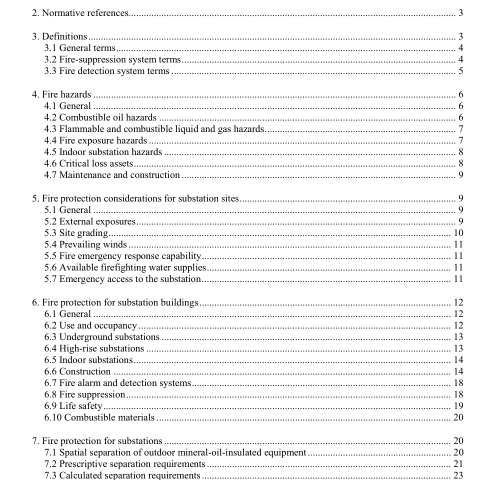IEEE 979-2012 pdf download.IEEE Guide for Substation Fire Protection
4. Fire hazards
4.1 General
The impact of fire hazards on health, safety, continuity of operations, and asset preservation is a reason to provide fire prevention, fire protection, and other fire safety measures. Fire hazards are the conditions that create the potential for a fire. Fire hazards have at least the following attributes:
⎯ The magnitude of a possible fire
⎯ The consequence of the potential loss
⎯ The probability of an occurrence over a period of time (i.e., risk)
Subclauses 4.2 through 4.7 present recognized fire hazards found in substations.
Refer to A.2 for additional information.
4.2 Combustible oil hazards
Based on mass and potential for energy release, mineral-oil-insulated equipment is normally the largest fuel source present in most substations. Mineral-oil-insulated equipment includes the following:
a) Transformers and reactors
1) Main tanks
2) Bushings
3) Radiators
4) Conservator tanks
5) Tap changers
6) Cooling pumps
b) Instrument transformers
c) Voltage regulators
d) Circuit breakers
e) Cables
1) Oil insulated
2) Pipe type
3) Potheads
4) Transition joints
f) Capacitors
g) Lubricating oil systems (e.g., for synchronous condensers)
h) Oil pump houses
i) Oil processing plants
4.3 Flammable and combustible liquid and gas hazards
Other equipment-related fuel sources that may be found at substations include the following:
a) Hydrogen-cooled synchronous condensers
b) Oxy-acetylene used for maintenance and construction purposes
c) Battery rooms
1) Heat from short circuits or thermal runaway
2) Hydrogen gas generated by battery charging
d) Diesel- or propane-fueled generators and fuel cells for backup power
e) Propane heating fuels
f) Flammable and combustible liquid storage, handling, and dispensing
4.4 Fire exposure hazards
Critical substation equipment and other assets can be compromised due to external fire exposures in addition to internal failure modes. Some example of exposure hazards include the following:
a) Auxiliary structures
1) Office areas
2) Warehouse areas
3) Oil storage areas
4) Shop areas
5) Stand-by diesel generator buildings
6) Hazardous materials storage areas
b) Any building, room, or support structure that is of combustible construction
c) Miscellaneous combustible storage
d) Vegetation (nearby forests, hedges, and shrubs).
4.5 Indoor substation hazards
Indoor substations present a unique set of hazards requiring a higher level of fire protection for the following reasons:
⎯ Any smoke and other products of combustion contained in the building can create an exposure hazard to building occupants, emergency personnel, and possibly a corrosive exposure to critical substation equipment.
⎯ Heat (flame impingement, radiative and convective exposures) and the blast pressures from fires and explosions contained within the structure can expose the structure and/or equipment to damage.
⎯ The egress of building occupants and access by emergency personnel for manual firefighting and rescue operations can be complicated by the smoke, heat, structural damage, and travel distances.
4.6 Critical loss assets
The following are critical elements of a substation that if destroyed or damaged can impact the substation’s ability to function:
a) Control, computer, protection, switchgear rooms, and equipment
1) System protection equipment
2) Communication equipment
3) SCADA equipment
4) Computers
b) Cable spreading areas, cable trenches, cable tunnels, and cable vaults
c) Batteries and charger systems
d) Station service transformers (dry or liquid filled)
e) Power transformers
f) Circuit breakers
g) Bus structures
h) Auxiliary equipment
The annexes provide more information on fire hazards and their potential impacts.
7 Maintenance and construction
Maintenance and construction activities can create high-risk conditions within substations. The following equipment and activities could present hazardous conditions:
a) Oil-processing equipment
b) Mobile transformers
c) Painting
d) Hot work (cutting, grinding, and welding)
e) Maintenance activities
f) Increased fire exposure and fuel load associated with
1) Temporary or permanent construction
2) Combustibles and flammable transient fire loads (e.g., fuel cans, rags, and wood)
3) Material and equipment storage
4) Office trailers
5) Parked vehicles
5. Fire protection considerations for substation sites
5.1 General
The following should be considered during new site selection or existing site analysis:
⎯ External exposures
⎯ Site grades
⎯ Available firefighting water supplies
⎯ Emergency access to the substation
⎯ Fire emergency response capability
⎯ Prevailing winds
⎯ Environmental consideration
Refer to A.3 for additional information.IEEE 979 pdf download.IEEE 979-2012 pdf download
IEEE 979-2012 pdf download

Leave a Reply